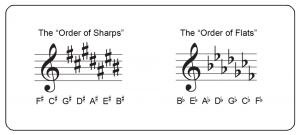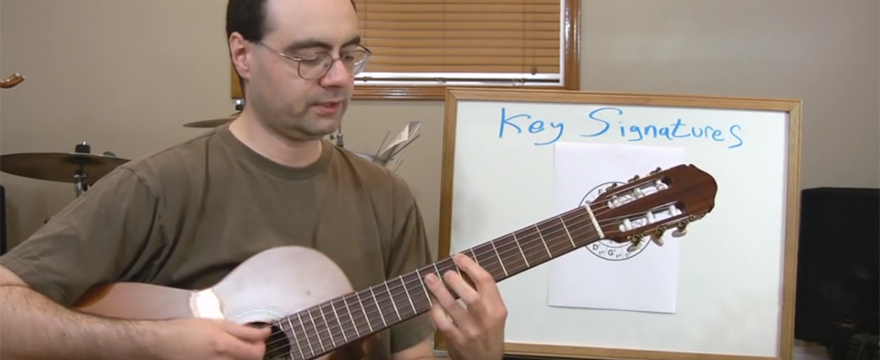Key signatures are used for defining the structure of a musical piece. When musicians read a music score, we apply the information that is found within the chart’s key signature in order to determine the note relationships, intervals and tonality. As guitar players, we form our judgment as to how we will perform a piece (along and across the fingerboard), largely based upon the key signature. This lesson breaks down the details behind understanding key signatures.
Q: I am more or less a beginner guitarist and I hope that you can help me with a good explanation about something called Musical Key Signatures.
So far, all I keep reading about is some concept to do with it called the, “Clock Theory.” It seems to be used all over the internet, but I just don’t get a number of things to do with this whole topic such as:
1). Why do we have to know about Key Signatures?
2). What can learning about this stuff do to help my guitar playing?
3). What does it all have to do with a Clock? It seems like most of the explanations online keep showing a clock. I just don’t see how music keys relate to clocks?
Thank you for considering my question,
Jacob – Halifax, NS. CANADA
A: Key signatures are a very important aspect of music. The key that a song is formatted in, along with the song’s tonality, (Major or Minor color), will work together to determine a number of critical factors that are directly related to the songs performance, (both musically and how you play it on guitar).
NECK RANGE /LOCATION:
For a guitarist, there are performance factors that are related to the song’s key. Most importantly, how and where the song will be performed along and across the guitar neck.
The key signature also indicates information to a guitarist about how the range of the piece will correspond to various fingerboard regions, (low, mid and high). This will be helpful to our choice of scale pattern positions as we read down the music score /chart.
THEORY:
Another important area that the key signature relates to is the general theory of the piece that you will be reading / performing. Everything from a songs intervals, to its chord names and chord qualities will always relate back to the key signature(s) that the song was composed in.
Some songs will modulate (change key), as the song progresses along. For example, many pieces will contain a final chorus section in where the music modulates up or down a whole step.
A song might also need to be transposed at some point as well. This is especially relevant if a music ensemble that you are working in ends up with a new singer. The new vocalist may require certain songs be moved (transposed) into a key signature that coincides better with their personal vocal range.
THE “CLOCK THEORY” (WHEEL) OF KEY SIGNATURES:
Musical key signatures are often discussed using the “Clock” theory method. This idea is based upon a circular cycle of keys, (also sometimes referred to as the “wheel of keys”).
The circular cycle of keys in the “clock /wheel” method can be thought of as either ascending, or descending, (moving from one key to another in either a clock-wise, or a counter clock-wise direction).
The Key Signature Clock /Wheel:

The key signatures within the clock theory wheel (shown above) move in 5th intervals (sharp keys) as they travel in a clock-wise direction.
However, when the direction is reversed – traveling in a counter clock-wise direction – we have an interval movement of 4th’s (flat keys).
As we travel through the clock, each new key will gain a new sharp (clock-wise), or a new flat (counter clock-wise). At the top position, (12:00 position), the ‘key signature clock’ corresponds to the neutral key of, “C Major.”
Every “5 minutes” clock-wise, (a “Perfect 5th” interval), we attain a new sharp key with a new sharp added. If we travel in reverse (the counter clock-wise, or the “flat’s” direction is a “Perfect 4th interval), we attain a new flat to each new flat key signature.
The phrase that many musicians will often use to relate to the key signature “cycle of keys” movement up and up is, “up a fifth / down a fourth.”
ORDER OF SHARPS and FLATS:
Keys add new sharps or new flats as they progress through the cycle of key signatures. The sharps and flats follow a systematic cycle as they are added to each new key and this creates an “order.” We refer to this systematic order as the, “Order of Sharps and Flats.”
The order of sharps is a sequence of seven sharp note names. This order tells us which notes are sharp (raised) in a key containing sharps. If a key has one sharp, it only contains the first sharp from the order of sharps — F#.
If the key has two sharps, it uses the first two sharps from the order of sharps — F# and C#. If a key had 5 sharps it would contain the first 5 sharps from the order — F#, C#, G#, D#, and A#.
The order of flats is also a sequence of seven flat note names. The flat order tells us which notes are flat (lowered) in a key containing flats. If a key has one flat, it only contains the first flat from the order of flats — Bb.
If the key has two flats, it uses the first two flats from the order of flats — Bb and Eb. If a key had 5 flats it would contain the first 5 flats from the order — Bb, Eb, Ab, Db and Gb.
Study the key signature orders shown in the diagram below…

CONCLUSION:
Key signatures can take some time to memorize, but they are most definitely worth knowing about due to their value for both song analysis and for their application to all areas of composition and improvisation.
Being able to properly read the key signature of a music score and understand exactly what it is telling you, is a valuable skill for fully comprehending any musical piece.
- Click the button below to download the lesson handout
(access to lesson material will require a FREE membership)
